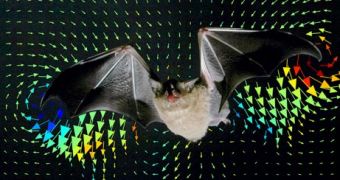Have you ever imagined a plane flapping its wings in the bat style?
The flexible flight of the bats, so different from the rigid wing beat of the birds, could be a model for new versatile aircrafts. A Swedish research resembles a previous American one, in trying to set up the details of the sophisticated bat flight in a wind tunnel to see how they differ from birds on staying aloft.
"Bats turn out to have a high degree of control over the ever-changing shape of their wings," said lead researcher Anders Hedenstr?m, an ecologist at Sweden's Lund University.
That's why they can generate lift while moving their wings both up and down, an extremely advantageous technique when hovering.
"The bats' trick resembles the way each rotor on a helicopter generates lift whether it's moving forward or backward," explained Hedenstr?m.
"By contrast, birds' wings are optimally designed to generate lift on their downstroke, and they can "feather" their wings-spreading their feathers like the slats of Venetian blinds-to reduce drag on the upstroke."
This matched the results found earlier this year by Brown University's Sharon Swartz and Kenny Breuer.
"Aerodynamic forces generated by bat wings during flight are far more complicated than those of birds. Bat wings are more flexible" said Swartz, an evolutionary biologist.
"The materials-the skin and bone-are more stretchy. The bones actually bend when the bat is flying. At slower speeds, flexible wings seem to have advantages."
In both researches the bats were placed in foggy wind tunnels and lasers and high-speed video cameras estimated how the bats' wing movements disturbed the fog. Flying aircrafts with batlike flapping wings would be more suited than the conventional ones in search-and-rescue operations and covert surveillance.
"Flapping flight is more versatile. You can fly at the slowest speeds and make tight turns, and fly into confined spaces." said Hedenstr?m.
"Such machines could also be hidden in plain sight. If you see something flying around in the sky that's not flapping, you know instantly that it's not natural. If it's flapping, you might not pay it any attention." said Swartz, whose research is funded by U.S. Air Force.

 14 DAY TRIAL //
14 DAY TRIAL //